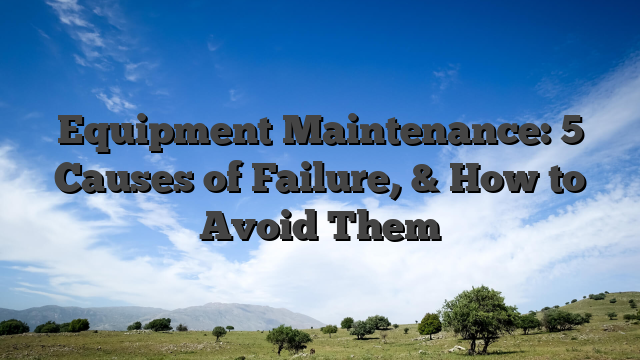For many industries, equipment asset management is the very basis of operational effectiveness. Not only do regular care and proactive precautions extend the life expectancy of equipment but they are equally vital for maintaining the financial, as well as the functionality of organizations. This means that a smooth-running machine leads to unbroken production lines, maximum output, and little disruption. Therefore, understanding why they don’t succeed within the landscape asset management will help them design ways that avoid such situations.
Cause 1: Inadequate Regular Maintenance
The absence of routine maintenance is among the significant causes of such malfunctions. Your equipment would also require a routine ‘health’ check just like you do with your body; it would warrant regular checks within the scope of medical equipment asset management.
One important factor to consider is that routine servicing detects minor concerns that would otherwise worsen and escalate to exorbitant costs. A small leak or an imperfection in a part, such as a misalignment, may be insignificant today, but tomorrow it could cause damage of a great magnitude.
Therefore, what can you do to make sure regular maintenance is not forgotten?
Create an all-inclusive maintenance plan. Further, employ automatic reminders or electronic aids to monitor service dates and part replacements. Also, it is important to make maintenance a key consideration in your firm as doing so may help you avoid unexpected problems.
Cause 2: Improper Operation by Users
One more frequent cause of failures in equipment maintenance comes as a result of their misuse by users. One disadvantage of well-maintained machinery is that even a little mistreatment will be reflected in their performance with the best ones. It is like driving a well-functioning car recklessly and leading to several accidents.
There are some common blunders that are made by operators such as the overload of equipment, disregarding of warning signals, and breaching safety standards. In addition, running inappropriate tasks on unsuited machines can have an impact on a machine’s early discontinuance.
Sufficient training will help eliminate most of these operational errors. Operators undergo regular training sessions so they understand what the machine can and cannot do. Moreover, the team may also require refresher courses on new safety procedures and operation techniques as well.
Cause 3: Wear and Tear Over Time
However, any machinery eventually gets worn out. As anyone who owns a pair of well-worn sneakers can tell you, machinery wears away with use. This is a normal phase of any product’s life cycle but does not imply that quick degradation could be prevented.
Firstly, we must realize that nothing in terms of equipment stands still. But, the acknowledgment of indicators of wear is imperative after all. As one example it is possible that the increasing shaking, strange noises, or decrease in performance might show components approaching their lifespan limit.
Furthermore, being proactive is important too. It’s recommended that one should plan for replacement or upgrade instead of waiting for a breakdown completely. This helps avoid sudden breaks and ensures perfect operating conditioning of the equipment. Furthermore, one cannot ignore the fact that often, costs related to fixing things preventively are way cheaper than those related to so-called emergency repairs.
Cause 4: Environmental Factors
Environmental factors undeniably have a significant impact on equipment maintenance lifespan and functionality. Just as humans require optimal conditions to function effectively, machinery, too, has specific environmental needs to operate efficiently.
At times, external conditions such as extreme temperatures, high humidity, dust, or even corrosive substances can accelerate equipment wear. For instance, machinery operating in coastal areas might face issues stemming from salty air, which can lead to rapid corrosion if not protected adequately. Similarly, equipment in arid regions may be more susceptible to dust accumulation, which can interfere with moving parts.
With strategic planning, the challenges posed by environmental factors can be largely mitigated. Firstly, awareness is key. Understanding the specific environmental challenges in your operating location can guide protective measures. Once you’ve identified potential threats, invest in protective covers, climate-controlled storage, or even specialized coatings to shield machinery from the elements. Moreover, ensuring proper ventilation and regular cleaning can minimize the buildup of harmful substances on your equipment.
Read More – IT hardware asset management
Cause 5: Poor or Wrong Replacement Parts.
Moving even deeper; another underlying reason for such failures is utilizing inferior or wrongly chosen substitute components.
The decision to use substandard or poor-quality parts may appear as a cost-saving measure in the short term. On the other hand, they are associated with frequent mechanical faults, low productivity, as well as danger in use. Furthermore, misfit parts may not fit into the existing machine causing an early wear and tear of neighboring components.
Thus, when sourcing for replacement parts, it would be wise to target high-quality ones. Check with the equipment’s manual for compatibility and always refer. Build relations with reliable suppliers and think about buying genuine spares. True, they may be more expensive initially, but they help maintain equipment integrity and avoid expenses brought by outages.
Preventative Measures and Best Practices
Predictive Maintenance Tools: Technology is capable of turning things around. In today’s world, predictive maintenance tools will warn you of probable issues before they turn into major problems. Such instruments, equipped with sensors, keep watch over machinery operation and give prompt reports that allow prompt actions.
- Operator Training: Recounting this earlier discussion, a highly informed team becomes your primary safeguard against operational slip-ups. Training is not just limited to improving the capabilities of a team, it also ensures safe and effective management of work tools as part of the regular team effort.
- Investing in Quality: Whether it’s replacement parts, maintenance services, or even the primary equipment purchase, quality should never be compromised. Remember, cutting corners might seem appealing initially, but it can lead to higher costs in the long run.
Equipment maintenance might seem like a daunting task, laden with technicalities and challenges. However, by understanding the potential pitfalls and adopting a proactive approach, you can significantly reduce the likelihood of unexpected breakdowns. With consistent care, awareness of environmental factors, quality investments, and a well-trained team, your equipment can serve you efficiently for years to come. Remember, in the realm of machinery, prevention is invariably better than cure.




